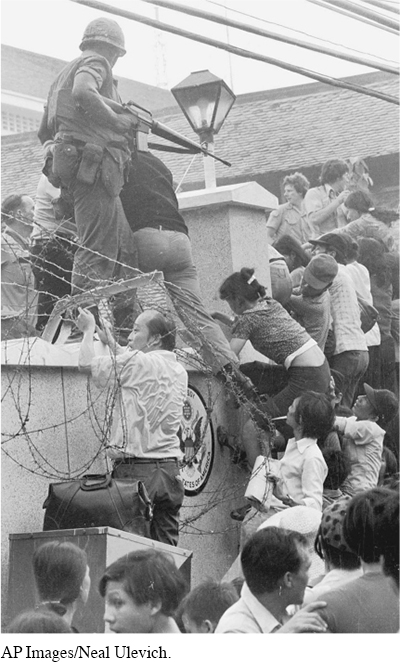The American Promise: Printed Page 854
The American Promise, Value Edition: Printed Page 772
The American Promise: A Concise History: Printed Page 884
The Peace Accords
The American Promise: Printed Page 854
The American Promise, Value Edition: Printed Page 772
The American Promise: A Concise History: Printed Page 884
Page 854Nixon and Kissinger continued to believe that intensive firepower could bring the North Vietnamese to their knees. In March 1972, responding to a North Vietnamese offensive, the United States resumed sustained bombing of the North, mined Haiphong and other harbors for the first time, and announced a naval blockade. With peace talks stalled, in December Nixon ordered the most devastating bombing yet. Though costly to both sides, it brought renewed negotiations. On January 27, 1973, representatives of the United States, North Vietnam, South Vietnam, and the Vietcong (now called the Provisional Revolutionary Government) signed a formal peace accord in Paris. The agreement required removal of all U.S. troops and military advisers from South Vietnam but allowed North Vietnamese forces to remain. Both sides agreed to return prisoners of war. Nixon called the agreement “peace with honor,” but in fact it allowed only a face-
The American Promise: Printed Page 854
The American Promise, Value Edition: Printed Page 772
The American Promise: A Concise History: Printed Page 884
Page 855Fighting resumed immediately among the Vietnamese. Nixon’s efforts to support the South Vietnamese government, and indeed his ability to govern at all, were increasingly eroded by what came to be known as the Watergate scandal, which forced him to resign in 1974 (as discussed in chapter 30). In 1975, North Vietnam launched a new offensive, seizing Saigon on April 30. The Americans remaining in the U.S. Embassy and their Marine guard hastily evacuated, along with 150,000 of their South Vietnamese allies. Confusion, humiliation, and tragedy marked the rushed departure. The United States lacked sufficient transportation capacity and time to evacuate all those who had supported the South Vietnamese government and were desperate to leave. A U.S. diplomat who escaped Saigon commented, “The rest of our lives we will be haunted by how we betrayed those people.” Eventually more than 600,000 Vietnamese fled to the United States, but others lost their lives trying to escape, and many who could not get out suffered from political repression or poverty.
The American Promise: Printed Page 854
The American Promise, Value Edition: Printed Page 772
The American Promise: A Concise History: Printed Page 884
Page 856U.S. Involvement in Vietnam
| 1954 | French colonial presence ends with Vietnamese victory at Dien Bien Phu. |
| Geneva accords establish temporary division of North and South Vietnam at seventeenth parallel and provide for free elections. | |
| United States joins with European, East Asian, and other nations to form Southeast Asia Treaty Organization. | |
| Eisenhower administration begins to send weapons and military advisers to South Vietnam to bolster Diem government. | |
| 1961– |
Under Kennedy administration, military aid to South Vietnam doubles, and number of military advisers reaches 9,000. |
| 1963 | Military coup ousts South Vietnamese premier Ngo Dinh Diem. |
| 1964 | President Johnson uses Gulf of Tonkin incident to escalate war. |
| 1965 | Johnson administration initiates Operation Rolling Thunder, strategic bombing of North Vietnam. |
| 1965– |
Number of U.S. troops in Vietnam increases, reaching 543,000 in 1968, but U.S. and ARVN forces make only limited progress against the guerrilla forces. |
| 1968 | Tet Offensive causes widespread destruction and heavy casualties. |
| Johnson announces reduction in bombing of North Vietnam, plans for peace talks, and his decision not to run for reelection. | |
| 1969 | Nixon administration initiates secret bombing of Cambodia, increases bombing of North Vietnam while reducing U.S. troops in the South, and pursues peace talks. |
| 1970 | Nixon orders joint U.S.-ARVN invasion of Cambodia. |
| 1970– |
U.S. troops in Vietnam decrease from 334,600 to 140,000. |
| 1972 | With peace talks stalled in December, Nixon administration orders the war’s most devastating bombing of North Vietnam. |
| 1973 | On January 27, United States, North Vietnam, and South Vietnam sign formal accord in Paris marking end of U.S. involvement. |
| 1975 | North Vietnam launches new offensive in South Vietnam, defeating ARVN. Vietcong troops occupy Saigon, renaming it Ho Chi Minh City. |

During the four years it took Nixon to end the war, he had expanded the conflict into Cambodia and Laos and launched massive bombing campaigns. Although increasing numbers of legislators criticized the war, Congress never denied the funds to fight it. Only after the peace accords did the legislative branch try to reassert its constitutional authority in the making of war. The War Powers Act of 1973 required the president to secure congressional approval for any substantial, long-
The war produced widespread criticism of the draft from both the left and right. As the United States withdrew from Vietnam, Nixon and Congress agreed to abandon conscription, which had been part of the Cold War since its beginning. Replacing the principle of obligation with the offer of opportunity, military leaders predicted that an all-